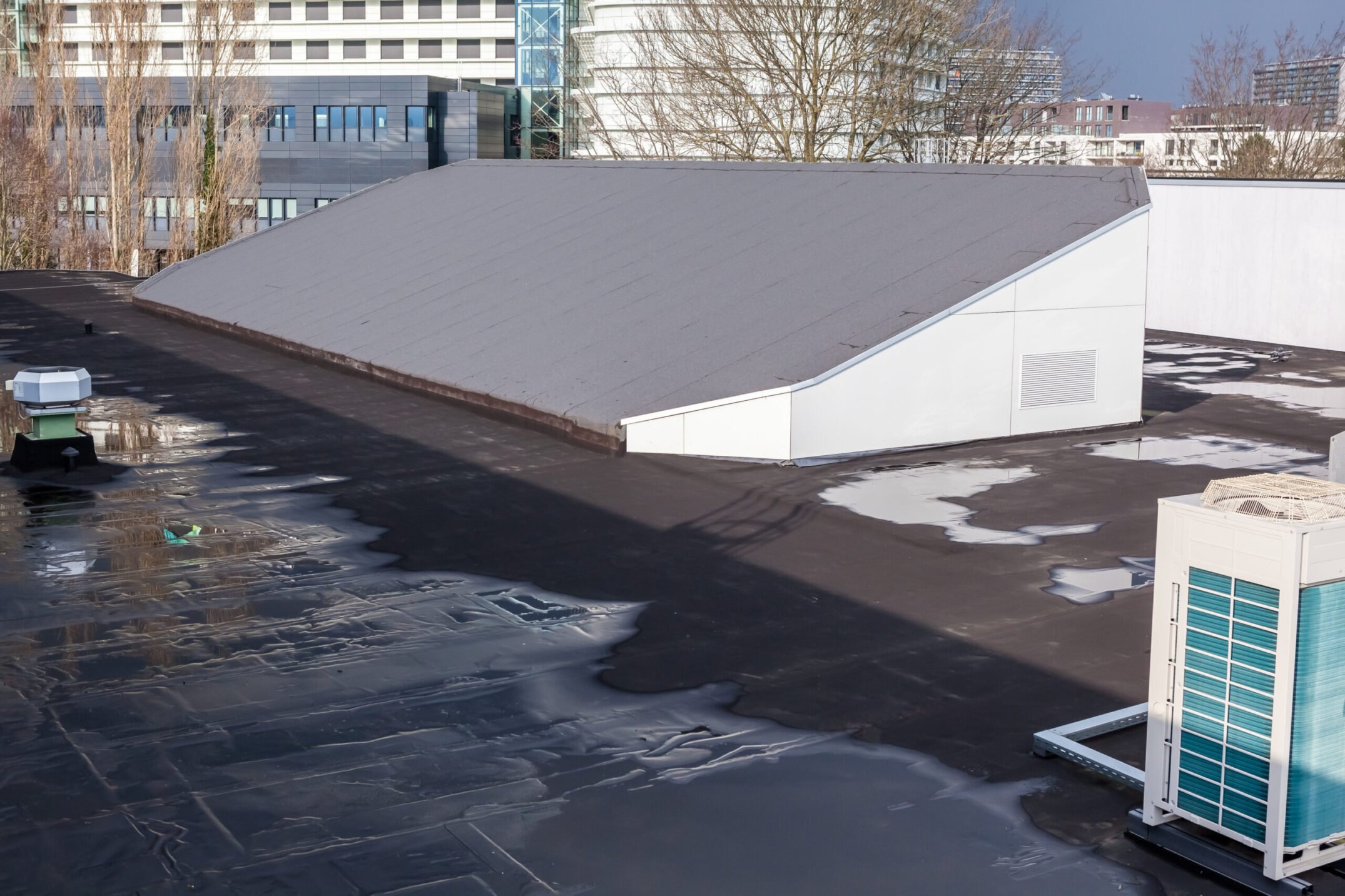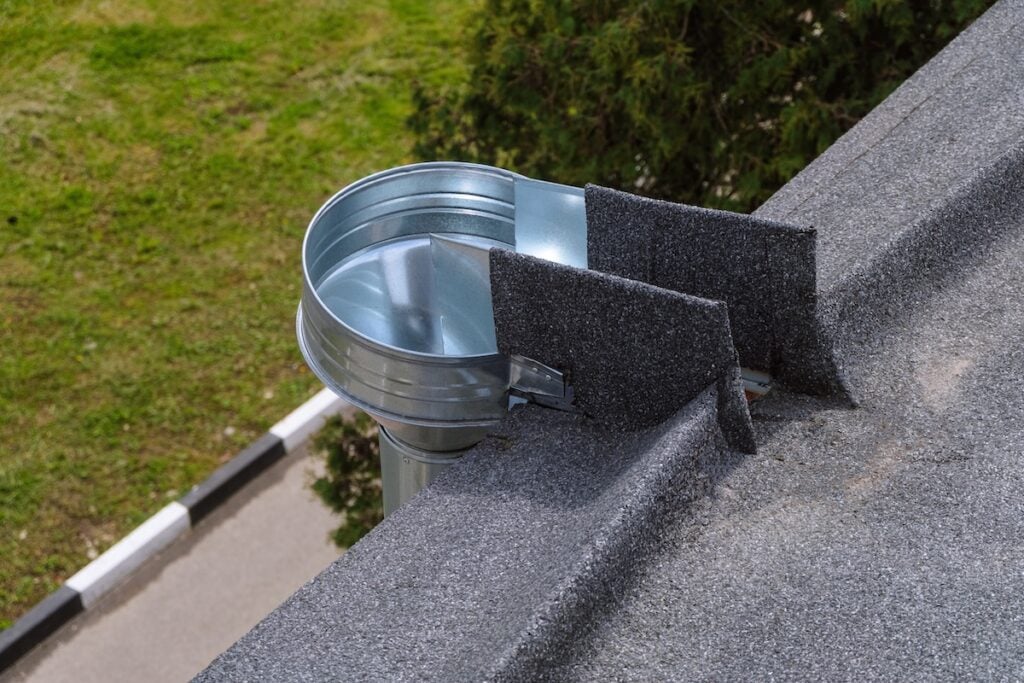Flat Roof Drainage: Best Methods For Water Removal
Posted 7.28.2025 | 7 Minute Read

Flat roofs are a popular choice for commercial buildings and modern residential properties, but they come with unique challenges that sloped roofs don’t face. The most critical challenge? Proper water management. Without effective flat roof drainage systems, standing water can lead to serious structural damage, leaks, and costly repairs.
Understanding how flat roof drainage works is essential for property owners who want to protect their investment. Poor drainage doesn’t just cause immediate problems like leaks and water damage. It can also lead to long-term issues, including membrane deterioration, structural weakening, and even complete roof failure.
Here’s what we’ll explore:
- Why proper flat roof drainage is critical for your property
- The best drainage methods and systems available
- Professional installation and maintenance considerations
🤔 Why Proper Flat Roof Drainage Matters

Flat roofs aren’t completely flat—they typically have a slight slope of about ¼ inch per foot to encourage water flow. However, this minimal slope means water moves much more slowly than it would on a traditional pitched roof. Without proper drainage systems in place, water can pool on the surface for extended periods.
Standing water creates multiple problems for flat roofs. First, it adds significant weight to the roof structure. A single inch of standing water weighs approximately 5.2 pounds per square foot. During heavy rainfall, this weight can quickly multiply and stress the building’s structural components.
The constant presence of water also accelerates the deterioration of roofing materials. Most flat roof membranes are designed to handle temporary water exposure, but prolonged contact with standing water can cause premature aging, cracking, and failure. This is especially problematic in climates with frequent rainfall or areas that experience freeze-thaw cycles.
Common Flat Roof Drainage Problems
Several factors can compromise the effectiveness of flat roof drainage systems. Recognizing these issues early helps prevent minor problems from becoming major headaches.
- Inadequate Slope Design: Poor roof design, such as insufficient slopes or areas sloping toward the center, leads to water collection. Flat roofs may also develop low spots over time due to structural movement, causing unexpected drainage issues.
- Clogged Drains and Gutters: Debris like leaves, branches, and dirt can block drainage systems, while winter ice dams and frozen outlets create blockages that prevent proper water flow. Regular maintenance is essential to avoid these problems.
- Membrane and Flashing Issues: Constant water exposure can deteriorate roof membranes and flashing near drainage points, leading to leaks and structural damage. Improper installation or aging materials often exacerbate these issues.
- Insufficient Drainage Capacity: Some systems can’t handle heavy rainfall or increased water flow caused by storms, weather changes, or building modifications, resulting in backups and poor drainage.
💧 5 Best Drainage Methods for Flat Roofs

Effective flat roof drainage requires careful consideration of your building’s specific needs, local climate conditions, and budget constraints. Here are the most reliable drainage methods available:
1. Interior Drain Systems
Interior drains are installed directly into the roof surface and connect to a pipe system that runs through the building’s interior structure. These systems offer several advantages for flat roof drainage applications.
The primary benefit of interior drains is their protection from freezing temperatures. Since the pipes run through heated building spaces, they’re less likely to freeze and cause backups during winter weather. This makes them particularly valuable in northern climates.
Interior drains also provide a clean appearance since all components are hidden from view. They don’t affect the building’s exterior aesthetics and aren’t subject to damage from falling debris or vandalism.
However, interior drain systems require careful installation to prevent leaks within the building structure. Any failure in the pipe system can cause significant interior water damage, making quality installation and regular maintenance essential.
2. Scupper Systems
Scuppers are openings in the roof’s parapet walls or edge details that allow water to drain off the roof surface. They can be used alone or in combination with downspouts to direct water away from the building foundation.
These systems are cost-effective and relatively simple to install. They provide reliable drainage without requiring complex pipe systems or interior modifications. Scuppers also offer easy visual inspection—you can quickly determine if they’re functioning properly from ground level.
The main limitation of scupper systems is their susceptibility to freezing in cold climates. Ice formation can block the openings and prevent proper drainage. However, this can be mitigated through proper design and the addition of overflow scuppers as backup drainage points.
3. Gutter and Downspout Systems
Traditional gutters and downspouts can be adapted for flat roof applications. These systems collect water from the roof edge and direct it through vertical downspouts to ground level drainage systems.
Gutter systems work well for buildings with accessible roof edges and provide good drainage capacity when properly sized. They’re familiar to most maintenance personnel and relatively straightforward to repair or replace.
The primary challenges with gutter systems on flat roofs include increased maintenance requirements and potential ice dam formation. Gutters must be kept clean and free of debris to function effectively, and their exposed location makes them vulnerable to weather-related damage.
4. Green Roof Drainage
Green roof systems incorporate vegetation and growing medium to naturally manage water runoff. While not suitable for all applications, these systems can provide effective drainage while offering additional benefits like improved insulation and reduced urban heat island effects.
Green roof drainage typically combines traditional drainage methods with specialized layers that retain some water for plant use while allowing excess water to drain away. These systems require specialized design and maintenance but can be highly effective in appropriate applications.
5. Tapered Insulation Systems
Tapered insulation creates positive drainage by building slope into the roof system itself. This method addresses drainage issues at the structural level rather than relying solely on surface drainage components.
By installing insulation panels of varying thicknesses, contractors can create consistent slopes that direct water toward drainage points. This eliminates low spots and ensures reliable water flow across the entire roof surface.
Tapered insulation systems work well in combination with other drainage methods and provide the added benefit of improved building insulation performance.
🛠️ Professional Installation and Maintenance

Proper installation is critical for any flat roof drainage system. Even the best drainage design will fail if installation is substandard or doesn’t account for local conditions and building requirements.
Expertise in Flat Roof Drainage
Professional roofing contractors understand the complexities of flat roof drainage and can assess your specific situation to recommend appropriate solutions. They consider factors like local rainfall patterns, building use, maintenance capabilities, and budget constraints when designing drainage systems.
Quality Installation Practices
Quality installation includes proper slope verification, secure attachment methods, and integration with existing roof systems. Professional contractors also ensure that drainage systems comply with local building codes and manufacturer specifications.
Importance of Regular Maintenance
Regular maintenance is essential for long-term drainage system performance. This includes routine cleaning of drains and gutters, inspection of membrane and flashing conditions, and prompt repair of any identified problems.
Benefits of Professional Maintenance Programs
Many property owners benefit from professional maintenance programs that provide scheduled inspections and preventive care.
👨🔧 Trust Coastal Roofing for Your Flat Roof Drainage Needs
When it comes to flat roof drainage, choosing the right team can make all the difference in protecting your property and ensuring long-lasting performance. At Coastal Roofing of South Florida, we bring years of experience, unmatched expertise, and a dedication to quality that sets us apart. Our team understands the unique challenges of flat roofs in our climate and works tirelessly to deliver tailored drainage solutions that prevent water damage and extend the life of your roof.
Whether you need an assessment, installation, or ongoing maintenance, we’re here to provide reliable service and exceptional results. Don’t leave your flat roof to chance—trust Coastal Roofing to safeguard your investment. Contact us today to schedule your drainage evaluation and let us help you protect your property with effective, long-lasting roofing solutions.
Recent Articles
